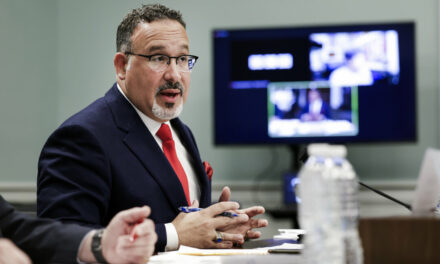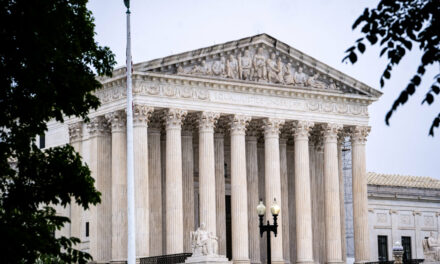We support our Publishers and Content Creators. You can view this story on their website by CLICKING HERE.
The G7 leaders are expected to announce a plan for unlocking frozen Russian sovereign assets to assist Ukraine.
PUGLIA, Italy—President Joe Biden on June 13 kicked off his meetings with the world’s seven wealthy democratic nations in Southern Italy to discuss a wide range of topics, including the conflicts in Ukraine and Gaza, economic security, and international cooperation on artificial intelligence (AI).
This year’s Group of Seven (G7) summit is hosted by Italian Prime Minister Giorgia Meloni in Puglia, a region known as the heel of Italy’s boot, famous for its rich history, sandy beaches, and olive oil production.
The three-day summit is taking place in the luxurious hotel resort of Borgo Egnazia, nestled among olive groves along the Adriatic coastline in the town of Savelletri di Fasano.
President Biden first participated in an official greeting with Ms. Meloni, host of the G7 Summit followed by a group photo with the bloc’s leaders. Other leaders attending the G7 summit are French President Emmanuel Macron, British Prime Minister Rishi Sunak, German Chancellor Olaf Scholz, Japanese Prime Minister Fumio Kishida, and Canadian Prime Minister Justin Trudeau.
In an election year, the G7 summit holds significant importance for President Biden. As with his recent trip to France, he is expected to use the occasion to stress the importance of alliances.
On June 14, President Biden will meet with Pope Francis, according to the White House. The Vatican confirmed in April that the Pope will join the leaders’ summit, participating in a special session on artificial intelligence (AI).
“This is the first time in history that a pontiff will participate in the work of a G7,” Ms. Meloni said on April 26.
World leaders expect to discuss a wide range of issues during the group’s 50th summit, including a roadmap to unlock frozen Russian assets to help Ukraine. During the summit, there will also be a session on the Middle East, where leaders will get an update from President Biden on the negotiations with respect to the cease-fire and hostage deal.
Plan for Russia Assets
The G7 leaders are likely to announce a plan for unlocking frozen Russian sovereign assets to assist Ukraine, an initiative that the United States has championed for a while.
“There’s been very good progress in the discussions among the G7 delegations here to reach an agreement on how to make that happen,” White House national security adviser Jake Sullivan told reporters on June 13.
“And hopefully, by the time the leaders meet today, we will have a common vision for the way forward. And the Italian presidency will be able to announce that there is a path forward. But we’ll all just have to wait and see what happens here in a few hours time.”
In the run-up to the crucial summit, the G7 finance ministers held discussions about the legality of using some $300 billion worth of frozen assets kept in European accounts as collateral for providing a loan to Ukraine for reconstruction. France was believed to be the main holdout on the plan.
President Biden mentioned before leaving France last week that he had reached an agreement with Mr. Macron on a plan to use the frozen Russian assets.
The proposal under discussion involves using the profits from the assets, specifically the interest earned, as collateral to provide Ukraine with a loan through a sovereign lender. Italy will capture the spotlight this week if the G7 leaders can agree on the details of this proposal.
“This has been something that the United States has put a lot of energy and effort into because we see the proceeds from these assets as being a valuable source of resources for Ukraine,” Mr. Sullivan said.
Biden, Zelenskyy to Sign Security Agreement
Following his meetings with G7 leaders on June 13, President Biden will sign a 10-year bilateral security agreement with his Ukrainian counterpart, Volodymyr Zelenskyy, signifying a continuing U.S. commitment to support the war-torn country against Russian aggression.
The security pact comes after President Biden and the leaders of the G7 countries agreed last year at the NATO summit in Vilnius that they would each sign bilateral security agreements with Ukraine.
So far, 15 countries have already entered into direct bilateral security agreements with Ukraine, according to the White House.
Mr. Sullivan briefed reporters ahead of the bilateral meeting, describing the agreement as a milestone moment.
“We think this is a big deal, a milestone moment in the partnership between the U.S. and Ukraine,” Mr. Sullivan said.
He added that the agreement is “a real marker” of U.S. commitment for the long term “both in defending against Russian aggression and in deterring future aggression so that Ukraine can be a sovereign, viable, thriving democracy.”
The security agreement, however, doesn’t include any commitment to use U.S. forces to defend Ukraine.
Mr. Sullivan declined to confirm if the United States will send another Patriot missile system to Ukraine, saying that an announcement would not be made during the Biden-Zelenskyy meeting.
President Biden reportedly approved sending the Patriot missile system to Ukraine in response to Kyiv’s desperate demand for additional air defenses as it confronts an intensive Russian assault on the northeastern Kharkiv region.
The decision, which was first reported by The New York Times, has not been publicly announced.
According to Mr. Sullivan, the security agreement does not include specific dollar figures for supporting Ukraine.
“It includes a commitment to work with Congress on sustainable funding going forward, which we will do,” he told reporters on June 12 on Air Force One en route to Italy.
“And it lays out a framework for how we work with Ukraine and with other allies and partners to ensure Ukraine has what it needs in terms of the physical capacity as well as the intelligence and other capacities to be able to defend itself effectively and to deter Russia.”
The president will meet with Mr. Zelenskyy for the second time in a week. The two leaders met in Paris on June 7 during the commemorations of the 80th anniversary of D-Day.

 Conservative
Conservative  Search
Search Trending
Trending Current News
Current News 







